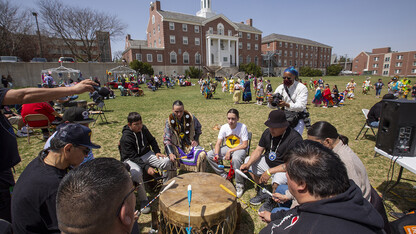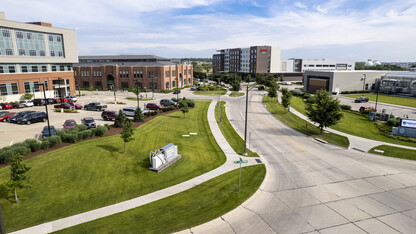· 5 min read
ANDRILL to deploy two drills for 2013-14 season

A team of eight drillers from the University of Nebraska-Lincoln will begin deployment to Antarctica next month as the Antarctic Geologic Drilling (ANDRILL) Science Management Office fields two hot-water drills to the grounding zone region of the West Antarctic Ice Sheet near the Whillans Ice Stream area of West Antarctica in the 2013-14 field season.
Led by Dennis Duling, senior research project manager for the Science Management Office, the team will recover and redeploy the UNL-designed and -built drill that last year became the first to succeed in penetrating the Antarctic ice sheet to reach a subglacial lake. It was the key piece of equipment in the Whillans Ice Stream Subglacial Access Drilling (WISSARD) project that broke through to Subglacial Lake Whillans in January.
It will also deploy a new roving hot-water drill that UNL scientists and engineers designed and built from existing systems under a new $575,000 National Science Foundation grant to ANDRILL’s Science Management Office at UNL. The mobile drill, which can penetrate a kilometer of ice, was constructed from parts of the hot water drill system that was used to create the IceCube Neutrino Observatory, an instrumented cubic kilometer in volume under the ice at the Amundson-Scott South Pole Station. The UNL team also used parts from the Kamb-Engelhardt Hot Water Drill, also known as the Caltech Drill, to create the new roving drill.
Frank Rack, executive director of the ANDRILL Science Management Office and an associate professor of Earth and atmospheric sciences at UNL, said the roving drill has been shipped to the U.S. scientific base at McMurdo Station in Antarctica, where it will be assembled by three of the UNL drillers. On Nov. 19, it will begin the 625-mile, 14-day traverse across the Ross Sea ice shelf to Subglacial Lake Whillans, where the WISSARD drill was stowed under a snow berm at the end of last year’s drilling season.
The UNL drillers will be flown on about Dec. 14 from McMurdo to Subglacial Lake Whillans, where three of them will take the roving drill off to drill 10-centimeter diameter holes into the ice at sites separated by about 50 kilometers. A team of scientists from the University of California, Santa Cruz, will use the holes to deploy an array of scientific instruments to study the movement of the Whillans ice stream as it moves a few meters a day toward the Ross Sea.
The other five drillers will dig out the WISSARD drill and prepare it to move to the grounding zone of the Whillans Ice Stream, where the continental ice sheet becomes an ice shelf over the sea.
“There’s a zone where the ice lifts up off the bed and becomes floating, so we’re selecting sites that will be as close to that zone as possible, but still be in liquid water so that they can take water and sediment samples, and look for biology in that environment,” Rack said. “We’ll also try to take some ice cores, using a hot-water ice corer, also inherited from Caltech, to take a limited number of cores at the grounding zone site, looking for biology in the ice and the amount of sediment carried in the basal surface of the ice.”
Rack said the WISSARD drill will operate just like last year, with clean drilling, water filtration, disinfectant and other safety features to collect pristine sediment, water and biological samples to compare the grounding zone environment with Subglacial Lake Whillans, which drains into the Ross Sea via what is in essence a subglacial river.
The roving drill, however, is not a “clean” drill, so it will not be used to penetrate all the way through the ice sheet and shelf.
In addition to Duling, other UNL drillers scheduled to deploy to Antarctica include Daren Blythe, Nathan Bowker, Justin Burnett, Chad Carpenter, Dar Gibson, Jeff Lemery and Graham Roberts. All but Bowker were part of the WISSARD project last year. Duling, Lemery and Bowker will operate the roving drill.
Rack said the team will operate the drills until late January and be off the ice by the second week of February.
WISSARD is a multidisciplinary research project funded by the National Science Foundation, Directorate for Geosciences, Division of Polar Programs, Section for Antarctic Sciences. The development and operations of the hot water drill system for the WISSARD Project is the responsibility of the ANDRILL Science Management Office at UNL. Funding for the drill system development, as part of the overall WISSARD Project, has been provided to the Science Management Office at UNL through three sub-awards: (1) Lake Ice Stream Subglacial Access Research Drilling (LISSARD), based at the University of California-Santa Cruz (UCSC, NSF-GEO-PLR-ANT #0839142); (2) Robotic Access to Grounding-zones for Exploration and Science (RAGES) based at Northern Illinois University (NSF-GEO-PLR-ANT #0839107), and (3) Geomicrobiology of Antarctic Subglacial Environments (GBASE) based at Montana State University (NSF-GEO-PLR-ANT #0838933).
Any opinions, findings, conclusions or recommendations expressed in these materials are those of the authors and do not necessarily reflect the views of the National Science Foundation or the U.S. Antarctic Program.







